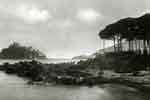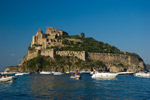In the western side of the island of Ischia, the country washed by the sea for the whole extension, surrounded by verdant plains, backed by the mountain that sits on the hills in the most luxurious and comfortable posture, flanked by two current volcanic, one to the north, another south; that country is called Forio.
It is bordered to the east and noon with the City of Fontana-Serrara; to the south with that of Ischia, to the north with that of Forio, on the west with the sea.
The main roads that put this town in communication, capture other neighbors are three: to the north and ends at Cavallara Lacco-Ameno, that of Fango to the north-east coast for half connects this town with Ischia, in the South that leads to the village of Panza, and continues to Serrara Fontana for steep climbs.
Beautiful, pleasant, are its breasts, its headlands, its bridges, and that we shall describe below these details.
Forio was called by Jasolino Fiorio saying: “Forino said by others, but by us Fiorio because after the destruction of many houses and castles that flourished, being the eldest of others throughout the island, well-equipped with twelve towers, with artillery , and with many people to fly, beautiful site of abundant wine, and excellent fruit”.
And De Siano also added the name of Forio etc. in Italian fertile: the name given to this place, because unlike other places of the island’s most fertile land to be the largest in the plan with the low hills, and therefore most suitable for growing and more fertile. Of this there can be no doubt, being also that until the present (1798), for this reason that the Earth looks like a city that contains the largest population of the island, multiplying the most fertile places in the competition of the inhabitants, the population is well all located together on a spit of land etc.
Forio includes: 1 main center of the country. 2 The village of Monterone. 3 The scattered houses. 4 The village of Panza.
In this arrangement the City, towns, countryside, the villas, the culminating point, from which begins the demarcation of Forio, Fasano called the east, below the summit Epomeo: the right side and northern Europe, the lowest point, the Cala di S. Montano, from which the proceeding is prolonged westward currents Zaro, or Caruso. From the mid-day the demarcation point from the boundary is called the Cross of Cola Jacono old farmer of Socchivo.
The first Greek colonies dwelt still Forio, in the opinion of De Siano.
These first Greek colonies, which settled on this plain, were the Doric, ie Siracuse, remained on the island under the Pacio Nimpsio Pacillo and Maio’s orders, after the defeat of lands.
Such an opinion was recorded by d’Aloysio, and repeated by the Anonymous Ultramontane.
From the foot of the hill to the valley of St. Emperor Montano, was a fertile and smiling plain: the Syracusans allured to that site, and while the enchanting beach subjected to the Emperor, erected their temple to Venus -whose white marble statue was discovered in 1792, and brutally destroyed.
From the opposite side, on top of the promontory of Vico, there was the wall of the fortress, which was submitted to the city to look west and dominate the existing cemetery in the subject valley, near the sea, to the entrance of town on highway as was the custom among Greeks, Romans, and hence one to establish their cemeteries.
The eruption of Caccavelli drove this colony, the same buried the city under the lava of Zaro and Marecoco.
The elements calmed down and ran the Partenopei, then the Romans.
The monuments discovered, the buried jars, the voices interfered in Latin Doric dialect, proved that the Neapolitan and Roman lived there.
Came the Sicilians, at the Julius Caesar time, bragging rights of ownership of the land occupied by the Neapolitans, having expelled Syracuse, they demanded the release. Julius Caesar had a right to their claim, and then the Sicilians occupied this country.
In this regard we report the d’ Aloysio’s words. Forio was originated by the Sicilians, who found a climate suited to their genius, they stopped there and multiplied, and called it Forio.
They broke the barbarians, these plains were devastated, the survivors took refuge in the mountains and hills.
With the Normans and Swabians remained with the impoverished island, and so the Syrians built churches, and multiplied, providing proof of indomitable perseverance and value.
Succeeded the Angevin dynasty, Sicily was touched at Vespers, and the children of Sicilians also rioted, calling for these plains: the French out.
The fertility of the place liked the new usurpers, and while the Charles II solders devastated these fields, the old settlers did not move away, with the eruption of 1301.
But back in 1305 and meeting votes, not to have been damaged in the property and in person, by the eruption of the cremation fire, they built churches and chapels in S. Antonio Abate.
The Spaniards occurring with the Aragons and Catalans, Sicilians, ran to plow or to occupy these vineyards and Lopez, the Galiz, the Jonchez planted here and with them ran to Corsica, and then others from Malta, which also took the House from the native land, and were called the Maltese, others from Matera in Apulia, took the surname of Mattera, and Matarese, others from Sorrento, Amalfi, Tuscany, are the Sorrentino, the Amalfitano, the Florentine, they give with their family name the first said, today House Jonchese, House Corso, House Calise, House Mattera, House Maltese, House Fiorentino..
It is bordered to the east and noon with the City of Fontana-Serrara; to the south with that of Ischia, to the north with that of Forio, on the west with the sea.
The main roads that put this town in communication, capture other neighbors are three: to the north and ends at Cavallara Lacco-Ameno, that of Fango to the north-east coast for half connects this town with Ischia, in the South that leads to the village of Panza, and continues to Serrara Fontana for steep climbs.
Beautiful, pleasant, are its breasts, its headlands, its bridges, and that we shall describe below these details.
Forio was called by Jasolino Fiorio saying: “Forino said by others, but by us Fiorio because after the destruction of many houses and castles that flourished, being the eldest of others throughout the island, well-equipped with twelve towers, with artillery , and with many people to fly, beautiful site of abundant wine, and excellent fruit”.
And De Siano also added the name of Forio etc. in Italian fertile: the name given to this place, because unlike other places of the island’s most fertile land to be the largest in the plan with the low hills, and therefore most suitable for growing and more fertile. Of this there can be no doubt, being also that until the present (1798), for this reason that the Earth looks like a city that contains the largest population of the island, multiplying the most fertile places in the competition of the inhabitants, the population is well all located together on a spit of land etc.
Forio includes: 1 main center of the country. 2 The village of Monterone. 3 The scattered houses. 4 The village of Panza.
In this arrangement the City, towns, countryside, the villas, the culminating point, from which begins the demarcation of Forio, Fasano called the east, below the summit Epomeo: the right side and northern Europe, the lowest point, the Cala di S. Montano, from which the proceeding is prolonged westward currents Zaro, or Caruso. From the mid-day the demarcation point from the boundary is called the Cross of Cola Jacono old farmer of Socchivo.
The first Greek colonies dwelt still Forio, in the opinion of De Siano.
These first Greek colonies, which settled on this plain, were the Doric, ie Siracuse, remained on the island under the Pacio Nimpsio Pacillo and Maio’s orders, after the defeat of lands.
Such an opinion was recorded by d’Aloysio, and repeated by the Anonymous Ultramontane.
From the foot of the hill to the valley of St. Emperor Montano, was a fertile and smiling plain: the Syracusans allured to that site, and while the enchanting beach subjected to the Emperor, erected their temple to Venus -whose white marble statue was discovered in 1792, and brutally destroyed.
From the opposite side, on top of the promontory of Vico, there was the wall of the fortress, which was submitted to the city to look west and dominate the existing cemetery in the subject valley, near the sea, to the entrance of town on highway as was the custom among Greeks, Romans, and hence one to establish their cemeteries.
The eruption of Caccavelli drove this colony, the same buried the city under the lava of Zaro and Marecoco.
The elements calmed down and ran the Partenopei, then the Romans.
The monuments discovered, the buried jars, the voices interfered in Latin Doric dialect, proved that the Neapolitan and Roman lived there.
Came the Sicilians, at the Julius Caesar time, bragging rights of ownership of the land occupied by the Neapolitans, having expelled Syracuse, they demanded the release. Julius Caesar had a right to their claim, and then the Sicilians occupied this country.
In this regard we report the d’ Aloysio’s words. Forio was originated by the Sicilians, who found a climate suited to their genius, they stopped there and multiplied, and called it Forio.
They broke the barbarians, these plains were devastated, the survivors took refuge in the mountains and hills.
With the Normans and Swabians remained with the impoverished island, and so the Syrians built churches, and multiplied, providing proof of indomitable perseverance and value.
Succeeded the Angevin dynasty, Sicily was touched at Vespers, and the children of Sicilians also rioted, calling for these plains: the French out.
The fertility of the place liked the new usurpers, and while the Charles II solders devastated these fields, the old settlers did not move away, with the eruption of 1301.
But back in 1305 and meeting votes, not to have been damaged in the property and in person, by the eruption of the cremation fire, they built churches and chapels in S. Antonio Abate.
The Spaniards occurring with the Aragons and Catalans, Sicilians, ran to plow or to occupy these vineyards and Lopez, the Galiz, the Jonchez planted here and with them ran to Corsica, and then others from Malta, which also took the House from the native land, and were called the Maltese, others from Matera in Apulia, took the surname of Mattera, and Matarese, others from Sorrento, Amalfi, Tuscany, are the Sorrentino, the Amalfitano, the Florentine, they give with their family name the first said, today House Jonchese, House Corso, House Calise, House Mattera, House Maltese, House Fiorentino..







